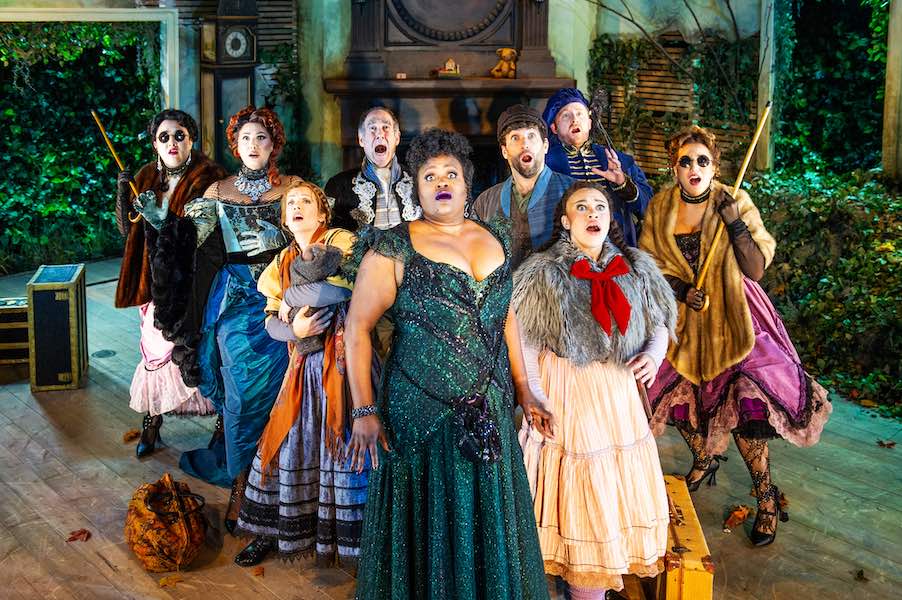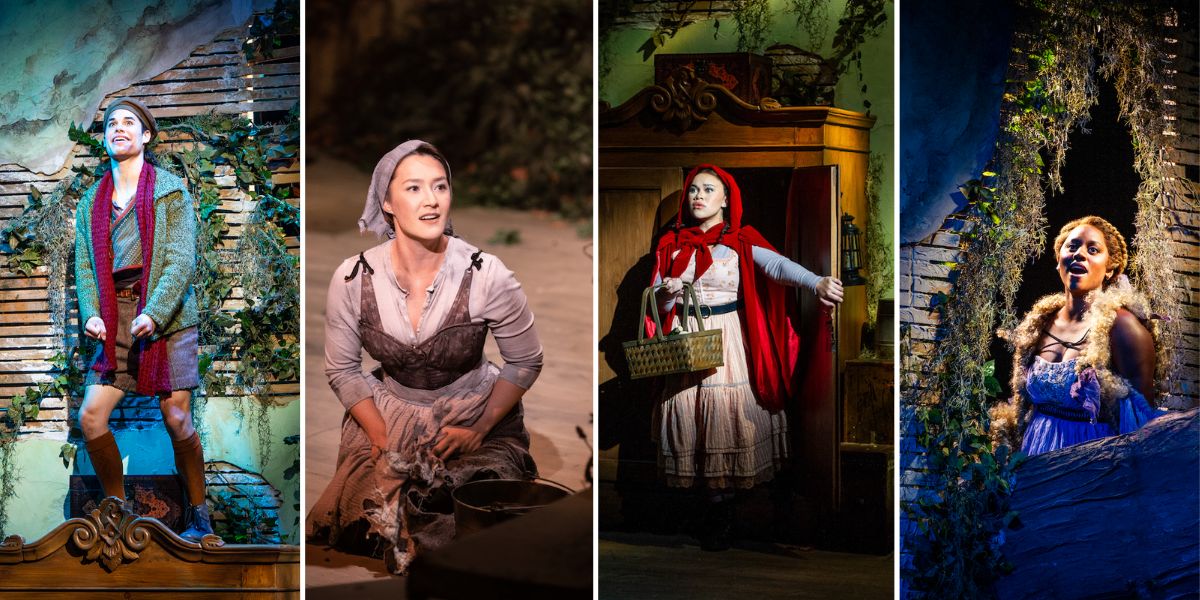“God is in the details” was one of Stephen Sondheim’s three key principles for his craft, “in the service of clarity, without which nothing else matters.” The theater gods are surely smiling at Signature Theatre’s deliciously detailed production of a Sondheim classic, Into the Woods, directed and choreographed by Matthew Gardiner with extraordinary clarity.
Start with Lee Savage’s set design, an apparently abandoned room returning to a state of nature, with an invading tree limb and foliage. All its features — a trunk, a wardrobe, a hearth, an old gramophone, a door not well secured on its hinges, a child’s cradle, a toy mobile with small white birds — do not simply establish the mood of the show but have one or more specific uses. Characters enter and leave through the hearth and wardrobe. The mobile becomes the flock of birds that plays an important role at key moments in the story. The gramophone introduces an appearance by Cinderella’s dead mother.

Beginning as it does with a familiar, interlocking set of folktales — Cinderella, Little Red Riding Hood, Jack and the Beanstalk, Rapunzel — the central focus of Into the Woods is telling stories and exploring their meaning. In the mode of great myths, the plot of Into the Woods is a quest story, two quest stories really. In the first, a Baker and his Wife (Jake Lowenthal and Erin Weaver), in order to break a curse imposed by the neighborhood witch (Nova Y. Payton) and have a child, must find four items, which brings them into contact, sometimes conflict, with Jack (David Merino), Cinderella (Kate Mariko Murray), Little Red (Alex De Bard), and Rapunzel (Simone Brown). They succeed, supposing that by getting their wishes they will live happily ever after.
The second quest is very different, as the characters must hunt down a giant (the very angry wife of the one that Jack killed) who is rampaging the land, squishing everything and everyone in sight. The very different survivors of her onslaught must band together to fight her, resolve their internal conflicts, and find a way home through the woods, in the process creating a very changed community. This quest involves arguably the best solo number in the score, the Baker’s Wife’s “Moments in the Woods,” in which Weaver shines; the heartfelt “No One is Alone” (sung primarily by Cinderella and the Baker); and the finale’s “Children Will Listen,” which, Payton again beginning in a quiet, lyrical mode, completes the play’s emotional arc.
In his book of lyrics, Look I Made a Hat, Sondheim points to the Baker’s Wife’s line “I’m in the wrong story” as the key to her character. The Baker and his Wife are a modern couple, somehow living in a world of witches and giants and magic. Lowenthal and Weaver play this aspect of the couple perfectly, their affect and ways of relating to each other, fighting and reconciling, and physicality being distinct from that of the other characters. It is easy to think of them in a play about a relationship in a city of today.

As Jack, a boy in short pants, Merino handles his number, “Giants in the Sky,” with the appropriate awe, beginning by standing on top of the wardrobe. He successfully plays the character’s youth and vulnerability, as well as his appetite for risk-taking. Speaking of appetite, it’s hard to compete with the ravenous Little Red, whom De Bard convincingly embodies as a very young person, albeit one you would not want to run afoul of in a dark alley. Her excellent “I Know Things Now” explores her grappling with the enticing and mysterious and threatening aspects of growing up.
Sondheim has always been a poet of ambivalence, and in Cinderella he and book writer James Lapine created a young woman who wishes strongly for something she finds she is unsure she wants, expressing her conflicted feelings very nicely in “A Very Nice Prince” and “On the Steps of the Palace.”
Three different women take on that word “nice.” Cinderella, as she is being mistreated by her mean girl sisters, recalls that while her mother told her to be good, her father told her to be nice. Little Red notes that the Wolf seemed nice and that “nice is different than good.” In “The Last Midnight,” the Witch has the last word on the subject: “You’re so nice. You’re not good, you’re not bad, you’re just nice. I’m not good, I’m not nice, I’m just right.” While it wouldn’t be fair to say that Sondheim has an overtly feminist agenda, this language acts to emphasize that niceness — as a feminine trait valued by men in the patriarchal society of these folk tales — may well limit the ability of women to be independent moral actors. And being responsible for one’s moral choices is of supreme importance to Sondheim in Into the Woods.

As for masculinity, there are the two princes (Vincent Kempski and Paul Scanlan), who pair up with Cinderella and Rapunzel respectively. In two versions of “Agony,” they one-up each other’s angst; every word or subtle movement the two actors make emphasizes their quite ridiculous competition. Kempski plays both Cinderella’s prince and Little Red’s Wolf, underlining the parallels between the Wolf’s attempts to seduce Little Red and the prince’s seduction of Cinderella. In a clever touch, Gardiner has the Baker’s Wife eavesdrop on the first act version of “Agony,” her evident interest foreshadowing her second act encounter with him.
The sometimes fraught nature of fatherhood is explored in the relationship between the Baker and the Mysterious Man. Motherhood comes in for examination as well. The Baker’s Wife desires it and is willing to compromise her moral scruples to get it. Jack’s frustrated mother (Sherri L. Edelen, in a standout performance) thinks that being childless wouldn’t be such a bad thing. Maria Rizzo, as the most charismatic evil stepmother ever (she’d be someone to reckon with in a TV reality show), oozes raw ambition for her offspring.
And then there’s the Witch, dysfunctionally protective of her daughter, Rapunzel. Payton is pleading and anxious with respect to Rapunzel in “Stay with Me” and despairing in “Witch’s Lament,” ultimately driving her deadly anger in “Last Midnight.” Payton does something with that song that I have never seen before, beginning it crooning to the Baker’s baby as she holds it, all the more menacing for singing the lines quietly. After her transformation, Payton plays her role as a fabulous but demanding diva, glittery green dress, ego, and outsize emotions to match.
The narrator (Christopher Bloch) enters the room to begin the stories. Far from being stationed at a lectern, as in some productions, he weaves among the other characters, brings the birds to Cinderella when she needs them, knocks over Jack’s cow to show its death, and sometimes gathers the ensemble around him for a moment of storytime. As played in this production, he is less outside the other characters’ stories than the glue that connects them.

Bloch also plays the Mysterious Man, whose song of regret and reconciliation with the Baker, “No More,” is a quietly emotionally wrenching sequence. Bloch transforms the Narrator into the Mysterious Man smoothly simply by donning a cape and hat and changing his character voice, intentionally blurring the line between the two characters and emphasizing that a narrator and a father figure are both storytellers whose words have consequences. It’s the most successful version of the dual characters I’ve seen.
Gardiner’s movement work in the ensemble, small group, and solo numbers is impeccable. The nearly constant movement is intricately timed to the music and lines, always enhances the characters, and never leaves the action static or the stage unbalanced. In contrast, a few intentional moments of stillness — “No More,” the beginning of “Children Will Listen” — gain all the more dramatic power.
The technical side of the production is equally adept. Amanda Zieve’s detailed lighting design fits the lines, music, and movement like a glove. Eric Norris’ sound design finds a booming highlight as the giant stomps toward, and sometimes on, the characters. Jon Kalbfleisch’s orchestra was on point throughout Sondheim’s complex score.
Signature Theatre is justly renowned for its Sondheim productions, and this Into the Woods joins its honor roll. It’s a complete theatrical package, down to the smallest detail, encompassing the deepest emotions of one of the greatest works of the American musical theater.
Running Time: Two hours 45 minutes, including one intermission.
Into the Woods plays through January 29, 2003, at Signature Theatre’s
MAX Theatre – 4200 Campbell Avenue in Arlington, VA. For tickets ($40–$109), call (703) 820-9771 or purchase online. Information about ticket discounts is available here.
This production is appropriate for all ages, but Signature does not admit children under 6.
The program for Into the Woods is online here.
Closed captions are available for every show via the GalaPro app.
COVID Safety: Through November 21, 2022, masks are always optional in the lobby and other public areas of the building but required while inside the performance spaces. Beginning November 22, 2022, masks are always optional in the lobby and other public areas of the building. Face masks are required inside the performance spaces on Thursdays and Sundays. Face masks are optional inside the performance spaces Tuesdays, Wednesdays, Fridays, and Saturdays. Signature’s COVID safety plans can be found here.





While this is a lovely review, I think the author of this piece doesn’t know that all of the “clever” choices from the director are, in fact, written in the script: the Baker’s Wife always eavesdrops on the first Princes’ song; and the Witch does indeed take the baby and sing to him in The Last Midnight.